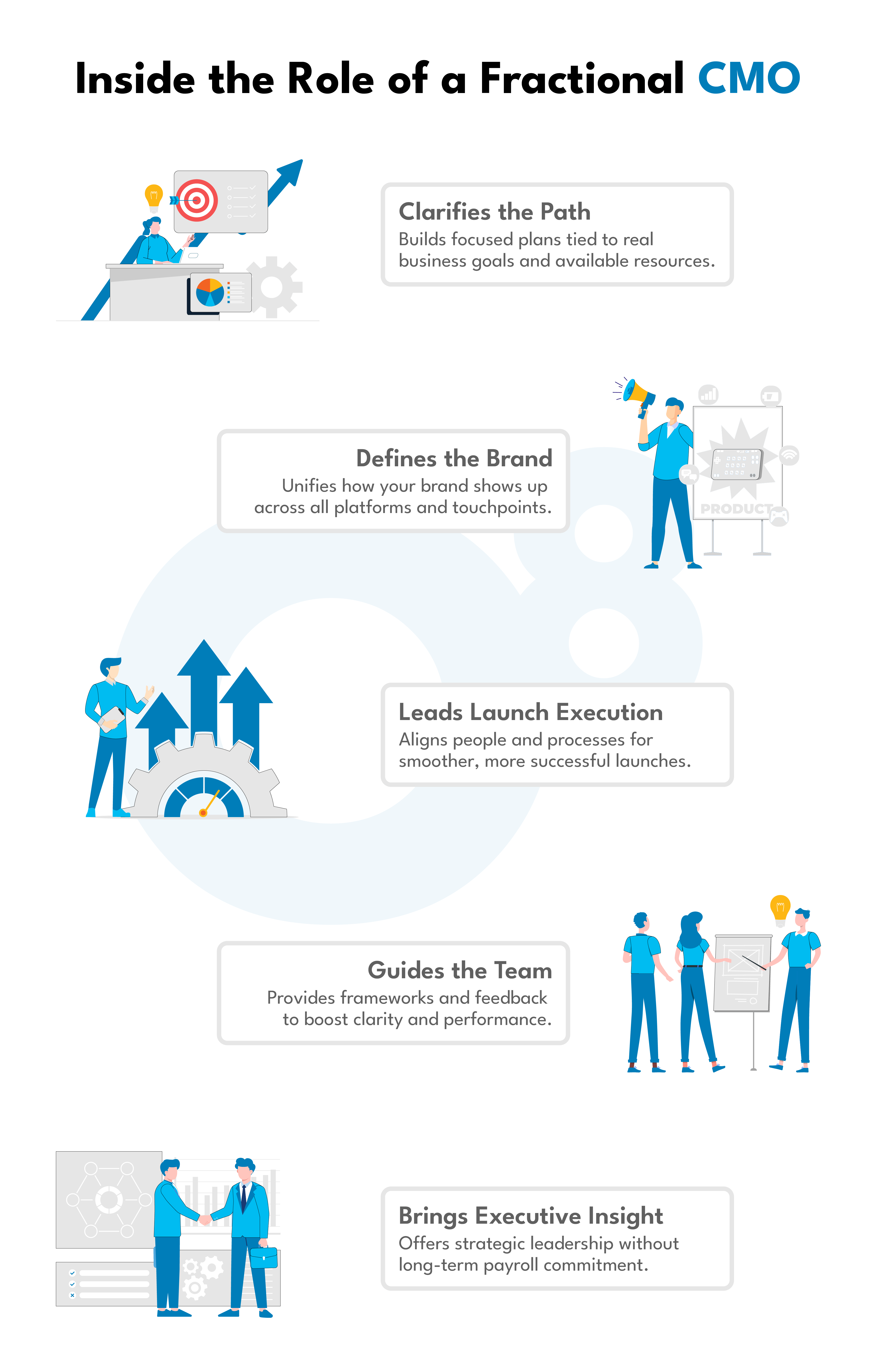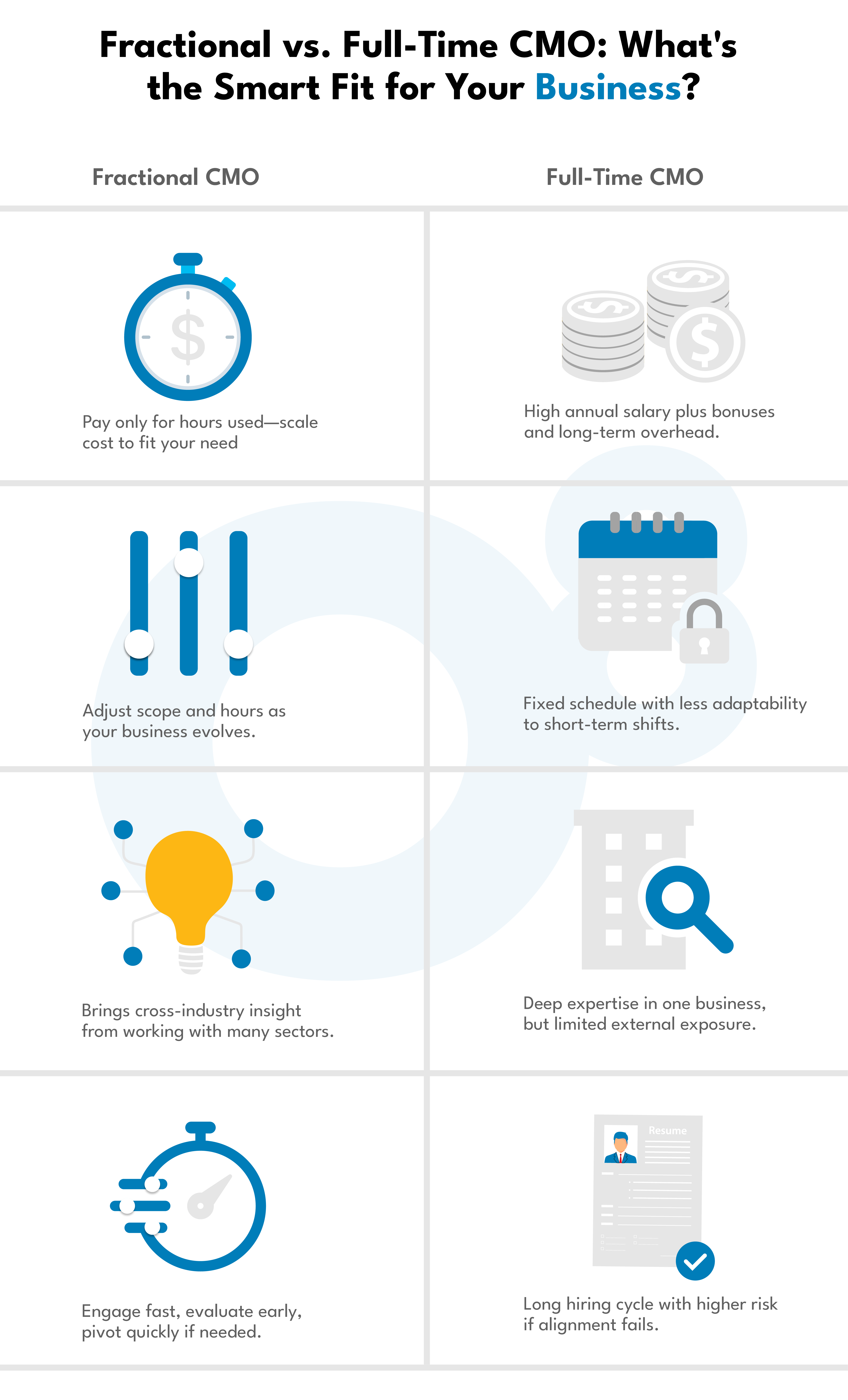What Founders Need to Know About Key Fractional CMO Responsibilities

- Fractional CMOs offer strategic leadership without the cost of a full-time executive, helping companies scale efficiently.
- With flexible access to C-level expertise, businesses can sharpen their strategy and accelerate growth.
- Setting clear goals and aligning internally ensures a fractional CMO integrates seamlessly into the team.
- Success shows through better lead quality, sharper marketing focus, and stronger overall business direction.
- By choosing a fractional CMO, companies can grow smarter without the long-term commitment of a full-time hire.
Most companies and founders assume that “real” marketing leadership requires a full-time executive deeply embedded in the organization. However, a report on fractional CMOs found that companies engaging fractional CMOs experienced an average revenue growth rate of 29%, compared to 19% for those without them.
Fractional CMOs offer high-level marketing expertise without the long-term costs or commitments of a full-time hire.They bring focused leadership, adaptable strategies, and align marketing efforts with broader business goals.
In this article, we'll explore how companies can leverage strategic marketing leadership through fractional CMOs, why more growth-stage businesses, and increasingly larger organizations, are adopting this model, and what a fractional CMO actually does to reach marketing objectives.
What does a fractional CMO do?
A fractional chief marketing officer oversees the entire marketing function of a business, from marketing strategy development and brand management to sales alignment, team leadership, and lead generation.
They perform the same core responsibilities as a full-time CMO, without the long-term cost or heavy internal management burden. Statista reports that as of 2024, the average CMO tenure at Fortune 500 companies is only 4.3 years, shorter than any other C-suite position.
This shift highlights the growing need for flexible, impact-driven marketing expertise and leadership models. Below, we’ll break down a formal fractional CMO job description, showing the key roles they fill and how they differ from traditional CMOs.
1. Marketing Strategy Development
A fractional chief marketing officer (CMOs) top key responsibilities is leading the marketing strategy to reach business objectives.
This includes building a go-to-market (GTM) strategy that defines target audiences, value propositions, marketing channels, and budget allocations. A recent report found that businesses engaging fractional CMOs were 36% more likely to achieve their long-term strategic goals compared to those without.
Unlike managing daily campaigns or posting on social media, fractional CMOs develop strategic frameworks that link marketing directly to measurable business outcomes such as pipeline growth and customer retention, and revenue acceleration.
2. Strategic Marketing Leadership
Just like your full-time marketing executive, fractional CMO can facilitate cross-functional alignment like syncing marketing, sales, and product teams around shared priorities. This ensures that marketing activities aren't operating in isolation but actively supporting revenue growth and following the latest market trends.
This leadership is especially critical today, with 64% of B2B marketing leaders reporting a lack of trust in marketing measurement for decision-making. A fractional CMO brings not only strategy but accountability—building performance frameworks that tie marketing directly to measurable business outcomes.
If you're considering hiring a fractional CMO to bring executive-level alignment without a permanent executive hire, the ability to drive strategic marketing leadership across departments is one of the most valuable returns on investment you have to vet for in your candidates.
3. Brand Management
On the brand side, a fractional CMO takes ownership of refining positioning, messaging, and customer experience across every touchpoint.
From sales presentations and landing pages to investor materials and marketing campaigns, their focus is on delivering clarity, consistency, and competitive differentiation.
Strong brand management isn't just about aesthetics, it’s about aligning perception with business goals. A fractional CMO ensures that brand messaging not only resonates with the target audience but also supports pipeline growth, customer loyalty, and revenue generation.
The options today are more flexible than this. Partnering with a fractional CMO agency offers growing companies more than just executive-level leadership. It provides access to broader branding expertise—creative teams, strategists, and specialists—ready to scale up or down based on specific business needs. This means brands not only benefit from strategic oversight but also from tactical branding execution supported by real-world portfolios and proven results.
4. Data-Driven Decision Making
A top priority for any effective fractional CMO is building a data-driven marketing system that ties every initiative back to business impact.
Rather than relying on vanity metrics, they create a key performance indicator (KPI) framework that links marketing activities directly to qualified leads, sales velocity, customer retention, and revenue outcomes.
A data-first approach is critical today. According to Forbes, companies engaging fractional CMOs often see a faster ROI because these leaders prioritize strategic focus, resource alignment, and measurement clarity, key areas where many growing businesses struggle.
How we address this in our fractional CMO service is using sprint-based cycles to test and optimize campaigns in real time, ensuring the marketing budget is constantly focused on what actually drives growth.
Instead of getting stuck in surface-level reporting, our fractional marketing leaders rebuild marketing as a true growth engine, one that moves faster, spends smarter, and supports the business where it matters most.
5. Adaptability and Focused Involvement
One of the greatest advantages of working with a fractional CMO is their ability to adapt their involvement based on what the business actually needs, without adding layers of complexity.
They focus sharply on the highest-impact growth levers, whether that means rebuilding lead generation, repositioning a brand, or tightening team performance. This flexible leadership model isn’t a compromise, it's a competitive advantage.
As businesses face pressure to scale efficiently, enter new markets, and sharpen operations, bringing in fresh leadership that can plug into a company’s structure without slowing it down becomes a strategic necessity.
Proven fractional CMOs dive in fast. They focus on diagnosing gaps, strengthening positioning, and building momentum without getting pulled into low-leverage work.
Unlike traditional full-time executives who often become stretched thin, fractional leaders know how to maintain strategic focus—and drive meaningful progress without getting buried in the day-to-day. For companies that want to grow faster without losing control, this kind of smart, adaptable leadership is a serious multiplier.
Hiring the wrong CMO can cost you more than money, it can cost you growth.
Take our 3-minute quiz and get clear on the smarter, more profitable option for your business stage.
What’s NOT the responsibility of a Fractional CMO
A fractional CMO is a strategic leader, not a hands-on executor. Their value lies in aligning marketing with business goals, not managing day-to-day tasks.
These are some of the things duties that fractional CMOs don't handle.
Here’s what typically falls outside their role:
- Writing or publishing content: They define the strategy, but don’t draft blog posts or upload them.
- Managing email campaigns: They map messaging flows but don’t write or build emails.
- Creating or posting on social media: They set campaign goals, not create or schedule posts.
- Designing marketing assets: They direct creative strategy, not produce ads, videos, or landing pages.
- Reporting on individual posts or campaigns: They review performance at a strategic level, not track every detail.

How Involved Can a Fractional CMO Be with Internal Operations?
A fractional CMO focuses on the highest-impact growth levers without getting pulled into daily execution. They often work within existing setups, managing internal teams, contractors, and agencies, improving handoffs, fixing workflows, and restructuring weak marketing functions when needed.
Because they operate with an outsider’s objectivity, fractional CMOs quickly assess team skills, marketing tools, and budget allocations to uncover gaps, misalignments, and wasted resources, things internal teams often miss.
Beyond immediate fixes, they help future-proof operations by:
- Mentoring marketing managers
- Advising on smart hiring decisions
- Clarifying roles to avoid overbuilding teams too early
What Makes a Fractional CMO Qualified Enough?
Successful fractional CMOs have a proven track record of leading through critical growth inflection points, such as post-funding expansion, market repositioning, or rebuilding a stalled pipeline. Industry-specific depth, such as B2B SaaS, healthcare, or manufacturing , can help, but broad experience across business models typically delivers even more value.
The best fractional CMOs:
- Step into existing teams and realign priorities fast
- Balance leadership and execution without needing corporate status
- Tie marketing directly to pipeline, customer retention, and revenue growth
- Mentor internal talent to leave behind a stronger, more self-sufficient marketing team
Their real value isn’t in adding complexity, it’s in simplifying what's broken and focusing resources where they move the needle most.
O8’s Success Story with Fractional Marketing
At Regroup, a leadership development firm, we brought our fractional marketing leadership and team helping the brand build buyer personas, refine messaging, and set clear performance benchmarks. This strategic groundwork drove better user engagement, improved lead tracking, and strengthened long-term growth planning.
Why Small and Scaling Businesses Are Hiring Fractional CMOs Before Full-Time Marketers
Hiring a full-time executive is a major commitment, especially for a small business balancing aggressive growth targets and limited resources. Increasingly, small and scaling companies are turning to fractional CMOs to bring strategic leadership, align marketing with business objectives, and drive faster results without the cost or rigidity of a full-time hire.
At the same time, the broader trend toward a leaner fractional marketing team is reshaping how companies scale.
Companies like Gamma AI are proving that smaller, high-impact teams, powered by flexibility and focused leadership, can outpace traditional models built on large permanent headcount.
Here’s a closer look at why fractional CMOs are becoming a cornerstone of smart growth strategies:
Driving Growth
The best fractional CMOs flex like outsiders but deliver like owners. They see gaps insiders miss, drive change without disrupting what works, and move fast without ego, politics, or distractions.
You can employ them full-time for targeted projects, like market research, rebranding, or go-to-market strategy, and then re-engage them as needed on a campaign basis.
Fractional CMOs offer strategic marketing support tailored to business needs, creating marketing plans that tie directly to business goals, regardless of industry, size, or model.
Strategic Marketing Expertise
Fractional CMOs bring strategic marketing expertise that helps startups and scaling businesses compete in fast-moving, competitive markets, without chasing every shiny new tactic.
They anchor decisions to real business objectives and measurable outcomes and evaluate new ideas through the lens of growth priorities. They also ignore distractions that don't serve key performance indicators (KPIs), revenue strategy, or market positioning.
Typically, fractional CMO services are priced at 50–75% less than a full-time executive’s salary and benefits, making them an attractive option for growing companies seeking C-level leadership without full-time overhead.
Businesses avoid costs like salaries, benefits, equity, and long-term commitments—while gaining senior-level leadership exactly when it's needed.
This model also reflects a deliberate career choice. Many seasoned executives pursue the fractional CMO path to focus on high-impact, strategic work across industries, free from corporate politics and bureaucracy. Their adaptability, and cross-industry strategic insight are not limitations—they’re their superpower.
Immediate Impact
Fractional CMOs assess marketing operations quickly, reset priorities, tie execution to measurable KPIs, and fix fragmented marketing. Their outsider perspective helps spot inefficiencies leadership may miss, driving immediate, focused improvements in lead quality, pipeline health, and brand clarity.
Fractional Marketing Support: When to Build In-House vs. Hire Experts on Demand
Hiring an 18-person in-house marketing department doesn’t make sense for most brands anymore, and for many, it never did. Even traditional agencies, once positioned purely as outsourced execution arms, are evolving.
Today, marketing agencies increasingly offer a broader mix of services that combine strategic leadership, martech support, and execution under one flexible, scalable model. That’s why a fractional marketing agency like O8 offers solutions designed to fit modern business growth needs:
Marketing-as-a-Service (MaaS):
A subscription model providing ongoing strategy and execution, led by a fractional CMO and delivered by a multidisciplinary team.
Managing CRM systems, marketing automation, analytics, and the technology stack, fully integrated into the company’s overall marketing plan.
Strategic Consultation:
Providing executive-level marketing leadership through fractional CMOs, while agency specialists deliver tactical execution aligned to business goals.
Director-Level Support:
Offering access to experienced directors and managers who can operationalize marketing strategies without the need for permanent internal hires.
Specialized Tactical Execution:
Delivering across paid media, content production, SEO, and inbound marketing, extending the CMO’s strategic vision into measurable outcomes.
O8’s Success Stories with Fractional Marketing
1. Ignited: UX, Content, and Funnel Optimization at Scale
Ignited, an EdTech startup scaling rapidly, realized that their outdated UX and leaking funnel were limiting growth. Despite strong demand, friction in their lead generation systems—and a small internal marketing team—made it difficult to capitalize on momentum.
O8 stepped in to lead a full reimagination of their marketing foundation. We redesigned the user experience to align with user intent, rebuilt critical funnel flows, and launched fresh inbound campaigns deeply integrated into their CRM system.Beyond design and execution, we provided strategic leadership that connected creative direction, operational flow, and customer journey mapping into one cohesive system.
Within just 60 days, Ignited saw a 40% increase in content engagement, a 25% drop in lead flow abandonment, and an 18% lift in qualified lead volume—all without expanding their internal team footprint.
Case study testimonial:
"For us, as a small department, O8 has been critical to our continued evolution. I truly feel as though I have more people working on the success of my business than what's listed on the payroll."
– Tracy Couto, Director, Center for Reflective Leadership, Le Moyne College
2. R3 Continuum: Scaling B2B Lead Generation
R3 Continuum needed more than just tactics. They needed strategic growth leadership that could drive qualified demand without the costs or complexity of rebuilding their entire in-house marketing function.
O8 provided leadership by delivering a holistic growth strategy that connected SEO, content marketing, and targeted campaigns into a clear, performance-driven system.
Rather than just focusing on traffic or ad spend, we prioritized building a pipeline infrastructure aligned to business objectives, ensuring every new lead was mapped to actual revenue opportunities.
The impact was clear. R3C achieved a 150% increase in inbound traffic, quadrupled their lead volume year-over-year, and added 500 new leads in just 90 days—all while keeping their internal resources focused where they mattered most.
Comparing Fractional and Full-Time CMOs
When choosing between a full-time chief marketing officer and a fractional CMO, you should weigh the differences in cost, flexibility, and potential insights. Here’s a closer look:
Cost Efficiency
Fractional CMOs often charge an hourly rate between $200 and $350. For instance, a fractional CMO billing $250 per hour and working 40 hours monthly could earn an annual salary of $120,000 from a single client. This arrangement allows for cost management tailored to business needs, unlike the ongoing expenses of a full-time CMO.
In contrast, the salary for a full-time CMO can range significantly, from $100,000 to over $400,000 annually, with a national average around $179,000 according to Glassdoor. This figure often includes additional costs like benefits and bonuses, which can further increase the overall financial commitment.
Flexibility and Adaptability
Fractional CMOs offer the flexibility to adjust their hours based on the company's current needs, making them an adaptable choice during periods of transition or growth. This flexibility, in contrast to the fixed nature of full-time roles, allows businesses to scale involvement up or down as required.
Industry Insights
With experience from multiple sectors, fractional CMOs bring valuable insights and can implement effective strategies quickly. Their exposure to diverse industries enables them to apply best practices across different contexts, enhancing strategic outcomes.
Risk Management
The hiring process for a full-time CMO can be lengthy and involves significant risk, as onboarding and proving ROI may take time. Fractional CMOs, however, can be engaged and evaluated much quicker, offering a lower-risk investment for immediate needs.
Not every business needs a full-time executive right away—which is why exploring alternatives to a fractional CMO, like agency partnerships or interim leadership roles, can also make sense depending on your growth stage. Read the full breakdown of what role fits your business more: Fractional CMO vs. Full-Time CMO vs. Virtual CMO?

FAQs
What is the primary role of a fractional CMO in a marketing strategy?
A fractional CMO owns the entire marketing function, shapes and leads a company’s marketing strategy by aligning campaigns, messaging, and planning with business goals. Their role typically includes brand development, go-to-market planning, and guiding the internal marketing team.
How does integrating a fractional CMO benefit small businesses?
Small businesses gain access to experienced marketing leadership without the cost of a full-time hire. A fractional CMO brings strategic focus, helps identify what’s working and what’s not, and supports execution where internal resources are limited.
What should companies consider when integrating a fractional CMO into their team?
Companies should start by setting clear goals and sharing key background information. It’s important to involve the CMO in early strategic planning and ensure internal teams are prepared to support the work. Regular communication helps keep things aligned and moving forward.
How can businesses measure the success of a fractional CMO's contributions?
Success can be measured by tracking improvements in key areas like lead quality, website performance, campaign results, and overall marketing clarity. Businesses should look at both short-term results and how well the strategy supports long-term growth.
Why choose a fractional CMO over a full-time CMO?
Hiring a fractional CMO gives businesses access to high-level marketing expertise without the full-time cost. It’s a good fit for companies that need strategic direction, but don’t yet require or can’t justify a permanent executive role.
What's the difference between a fractional CMO, an interim CMO, and a marketing consultant?
A fractional CMO leads marketing strategy part-time, offering strategic guidance without full-time costs. If a company needs full-time leadership during a transition, an interim CMO steps in temporarily. When businesses need help with specialized advice without hands-on leadership, they should turn to a marketing consultant.
Conclusion
Hiring a fractional CMO isn’t a stopgap, it’s a strategic decision for companies in need of marketing leadership, minus the FTE.
When growth matters but resources are tight, fractional marketing leadership gives companies what they need most: clarity, speed, and sharper execution without unnecessary overhead.
The key to making it work isn’t treating a fractional CMO like an outsider. It’s embedding them into the business, setting clear goals, sharing context, and aligning teams around measurable outcomes.
The real advantage isn’t just doing more marketing, it’s doing the right marketing. A strong fractional CMO will help you cut noise, spot overlooked gaps, and deliver a comprehensive marketing strategy as a serious driver of your business' growth. In the end, it’s not about adding complexity. It’s about building a marketing system that finally pulls your business forward.
Grow Faster by Spending Smarter
Lead your industry with strategic marketing that eliminates waste, sharpens your focus, and delivers measurable growth.








